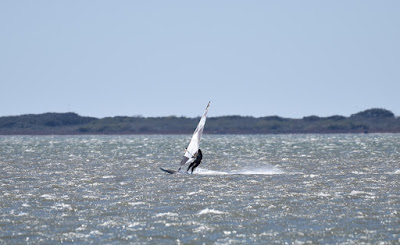.jpg) |
| Surfer's Eye (Pterygium), caused by UV and wind exposure |
Good sunglasses will absorb 99-100% of the UV; prescription glasses with polycarbonate lenses will do the same. But windsurfing will lead to water drops on the glasses, which disturb the vision. I typically sail on salt water, which is worse - when the water droplets dry out, they leave a thin film of salt on the glasses. And, of course, you can loose glasses when you fall. So when I switched to daily contact lenses for windsurfing several years back, I thought things had gotten a lot better.
My eye doctor said that I may have another 15 or 20 years before I need cataract surgery. That's when they make a little incision in the lenses in your eyes, and suck out the milky-white protein stuff that has accumulated over the years (and now inhibits your vision, and makes driving at night painful). They replace it with a bit of clear plastic. This is the most common surgery in developed countries - in Germany, it's done six hundred fifty thousand times per year. The risk of complication is small, perhaps 1%, and 90% of all surgeries improve vision. But there is a risk, however small it may be, so I'd rather delay the surgery as much as possible. Considering how quickly the cataracts developed over the past 3 years, the doctor's estimate probably would be too optimistic if I'd just keep windsurfing without any eye protection!
So I had to get glasses for windsurfing. In the past, I typically paid about $500 for a pair of glasses. That's just too expensive for something that I might loose at any time in a crash! But I needed something quickly - sailing without contacts or glasses is just to damn uncomfortable, since I can see neither the wind nor the chop well enough. I ended up getting two pairs of glasses for $200. The frames are cheap, and mostly picked because they looked sturdy. The lenses where upgraded to polycarbonate, the lens material suggested for sports since they are less likely to break.
The first time I used the glasses, the water droplets on the lenses took some getting used to. But the next couple of sessions, everything was fine, and I barely even noticed that I was wearing glasses. Things changed dramatically during our last speed session, though: my vision continuously got worse during each run. When I got of (fortunately in knee- to hip-deep water), I saw that the water on the lenses had dried, and left a thin salt film. So for the rest of the session, I ended up washing my glasses after every few runs, followed by shaking the drops off.
So what caused the difference to the previous sessions? The wind direction! This time around, we had northwest wind. Unlike the typical SE wind, which comes from the ocean, NW comes from the land. It's always dryer, but with virtually no rain so far this year, it was extremely dry - dry enough to dry saltwater drops in a minute or two.
I had been thinking about getting prescription sunglasses with polarized lenses, anyway, since the glare of the sun on the water in the afternoon often is quite bad. The local store wanted about $150 for the the lenses alone, plus another $100 for "sports" frames that I did not really care for. Next stop was the web. Zennioptical.com has tons of frames for $30 or less, and offers polarized polycarbonate lenses for $72. I also really liked their system where you can upload your picture, and then "try on" glasses that are super-imposed onto the picture. Very easy to try on dozens of frames in a few minutes this way! Unfortunately, they did not have any sports frames that would work for windsurfing.
Just then, Nina mentioned that she had seen a web site that offered sunglasses specifically for water sports - Silverfish.com. They primarily address surfers, but that's simply because in the US, there are 100 surfers for every windsurfer. Their sunglasses have essential features like retaining straps, are reasonably priced, and are also offered as prescription sunglasses - perfect! They offer clear advice, for example which of their frames to pick depending on head size and conditions, and which coatings or lens types make sense - great! And since they are targeting water sports, they also offer a "Hydrophobic Anti-Droplet/ Anti-Fog Cleaning Liquid Bundle". Cool. I placed my order right away, and should get the glasses in less than 2 weeks.
--
Update June 30, 2016: I received the Silverfish sunglasses quickly and liked them a lot, especially the retaining system. However, one of the lenses developed a small crack on the inside after a couple of weeks. A few weeks later, the second lens also developed a similar crack. At first, they seemed to be stable, so I put off contacting the company for a replacement - I was using the glasses every week! Then, on June 29, after using the glasses for about 3 months for windsurfing, I accidentally touched the glasses with a harness like while beach starting in small Kalmus chop. No big thing, but my vision seemed funny all the sudden. So I took the glasses off, and one lens had popped out! I wear glasses all the time, and have had much worse things happen a lot without lenses popping out. I was in hip-deep water near shore, but the water was a bit murky, and I could not find the lens again. I have contacted Silverfish about a warranty replacement. I'll keep you posted on the outcome!









